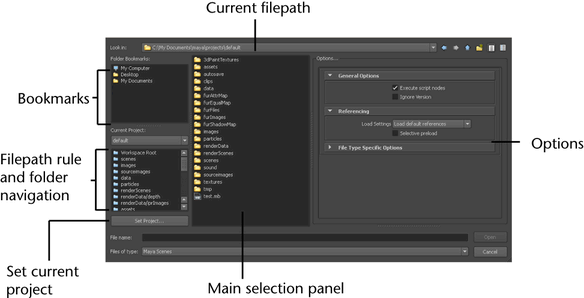- The file browser appears when you save, open, import, export, or otherwise navigate your computer’s file system.

Folder Bookmarks
Click any folder in the Folder Bookmarks to navigate to that folder instantly in the main selection panel.
You can customize these bookmarks by dragging and dropping folders into the upper-left panel.
Current Projects
Change the current project by clicking the drop-down box and selecting a project. Maya displays all recently opened projects.
You can quickly navigate to the various folders where project files are stored by clicking the appropriate folder in the panel below the Current Project drop-down. This panel contains both folders defined by the project’s rules and folders located in the project’s root directory.
You can return to the root of the project at any time by clicking Workspace Root.
Common options
The options available in the default Maya file browser change depending on the operation you used to open the file browser. However, in all versions you can do the following:
- Quickly navigate to recently saved locations by clicking the drop-down menu next to Look in and looking in the Recent Places section.
- Edit your file path in the Look in field using its auto completion functionality
- Navigate your computer’s file system from the file browsing panels or enter file paths directly into the File name path.
- Navigate your file system relative to your current location with the up, back, and forward buttons, create new folders with the new folder button and adjust how much file details are shown by switching between the List view and Detail view.
- Preview images by selecting them in the main selection panel. Preview images appear in the Options panel on the right side.
- Set the current project by clicking the Set Project button and selecting a folder from the mini file browser that appears.
- Press Alt + middle scroll (Windows and Linux) or Shift + middle scroll (Mac OS) to scroll through the entries in the File Browser window.
- Filter filenames by typing wildcards in the
File name field and pressing Enter. The results are displayed in the main selection panel.
Supported wildcards include the following:
- * - Denotes all strings of any length.
- [] - Denotes a specific or range of characters.
For example, inputting *[0-9].ma returns all .ma files ending in a single digit.
- Switch to your operating system’s native file browser in the Preferences (Window > Settings/Preferences > Preferences). In the File/Projects section, set File Dialog to OS native.
Operation-specific options can be found in the
Options panel on the right side and are identical to those contained in their respective option boxes (![]() ).
).